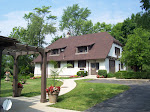Mass transit has had an important role in the history of
Youngstown.
Since the 1870s, there has almost steadily been some form of mass transportation in the city.
The first
horse-car, a streetcar pulled by horse on tracks laid throughout city streets, made its debut
May 5, 1875.
The route stretched from
Jefferson Street in Brier Hill to
East Federal Street downtown.
The horse-car line was operated by the Youngstown Street Railroad Company, which charged a fare of less than six cents per ride.
 An electric streetcar operated by Mahoning Valley Electric Railway,
An electric streetcar operated by Mahoning Valley Electric Railway,
established in 1894 to run from Youngstown through Girard to Niles.
Electric streetcars took the place of horse-cars in the 1890s.
The newly formed Youngstown Street Railway Company, the product of a merger between two horse-car companies in
Youngstown, was given permission by the city to build a new electric streetcar line.
The new line expanded upon the original horse-car service, including routes from Brier Hill to
Haselton,
Elm Street to Broadway, and
Mahoning Avenue to Belle Vista.
The first run of the new electric car took place
April 29, 1891.
The car was powered by two 15-horsepower electric motors that took electricity from wires above the street.
 Streetcars share the road with automobiles and pedestrians
Streetcars share the road with automobiles and pedestrians
on Market Street near the Mahoning County Courthouse, 1920.
Other railway companies soon emerged to expand service throughout Youngstown and outlying towns. The Mahoning Valley Railway Company, the product of yet another merger, formed subsidiaries like the Mahoning Valley Southeastern Railway which extended lines through East Youngstown (now Campbell) and Struthers in 1899, and Lowellville in 1900. Youngstown’s steel industry was growing, and rail lines provided steel workers with convenient transportation to and from the mills.
Streetcars were used for more than just work transportation. The Youngstown Park & Falls Street Railway received the franchise for a nearly 5-mile route that connected Central Square downtown to an amusement park near Lanterman’s Falls in Mill Creek Park. Service to Terminal Park (later Idora Park) began on May 30, 1899, and was situated on a loop that became the most-traveled line in Youngstown, much to the chagrin of the competing Mahoning Valley Railway Company.

Buses of the Youngstown Municipal
Railway Service line Market Street in 1930.
By 1906, all of the competing railway companies save one merged under the umbrella of the Mahoning & Shenango Railway & Light Company. The Youngstown & Southern Railway Company, whose route went from Front Street out of Youngstown to Columbiana and Leetonia, was not a part of the merger. In 1918, after complaints of poor railway service within the city, Youngstown officials decided to separate city service from all other local railway service. They wanted a company that would solely operate lines within Youngstown. The Mahoning & Shenango (known as Penn-Ohio by 1920) created the Youngstown Municipal Railway Company in order to bid on the franchise, and agreed to keep its city operation from the rest of the rail system.

A moneychanger used by Youngstown Municipal Railway
driver Ken Matteson, along with a 1947 bus pass and fare tokens
In 1922, Youngstown Municipal Railway Service introduced bus service to the city. Buses were a deluxe alternative to streetcar travel. With comfortable, leather seats in stark contrast to the wood and rattan of streetcars, buses became the preferred mode of transportation. Buses were not limited by tracks, offering versatility not available with streetcars. On March 23, 1923, the Williamson Avenue streetcar line was abandoned – the first of many – in favor of faster bus service to downtown.

Buses run next to streetcar lines as passengers
wait to board on West Federal Street, looking east.

West Federal Street in front of Lustig's Shoe Store, 1951.
Streetcar lines steadily gave way to buses, and the Youngstown Municipal Railway Company became the Youngstown Transit Company in 1957, reflecting the change. But by the 1950s, the popularity of the automobile threatened to make mass transit in Youngstown extinct. With income steadily falling, Youngstown Transit in 1970 turned operations over to the Mahoning Valley Regional Mass Transit Authority, which sought government funding for public transportation. The Mass Transit Authority gave way to the Western Reserve Transit Authority in 1971, and WRTA continues to provide transit services to Youngstown and outlying communities.
 Streetcars share the road with automobiles and pedestrians
Streetcars share the road with automobiles and pedestrians










4 comments:
I go to horse races all the time and spend all my money to the best bitter, I don't know why I always win the the third horse. I'm praying so I can get the first horse and get the money I deserve. I use modern transportation for my horses all the time, it's for their own safety.
I am very much pleased with the contents you have mentioned. I wanted to thank you for this great article. Bus Replacement
Just admiring your work and wondering how you managed this blog so well. It’s so remarkable that I can't afford to not go through this valuable information whenever I surf the internet! Transport Marketplace
Post a Comment